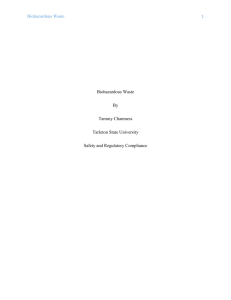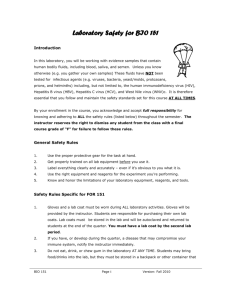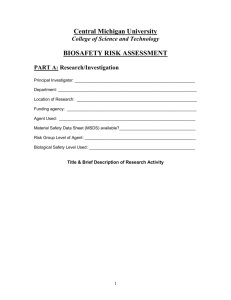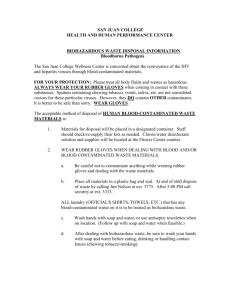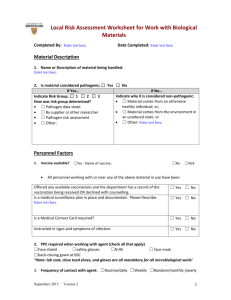UCCS S O P AFE
advertisement
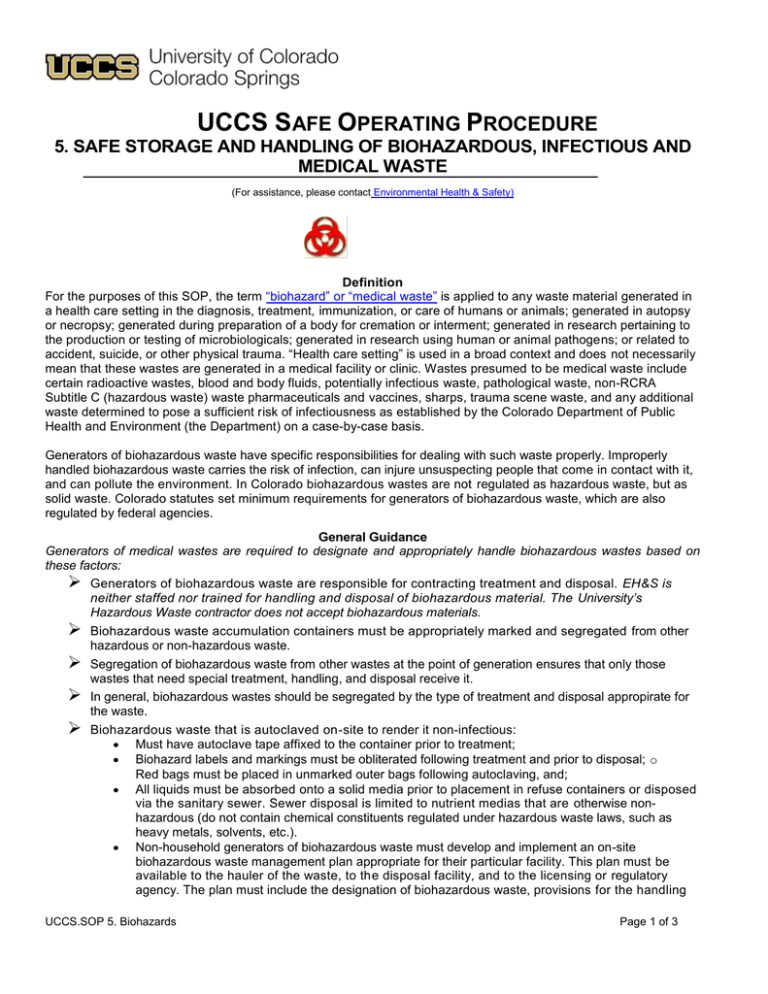
UCCS SAFE OPERATING PROCEDURE 5. SAFE STORAGE AND HANDLING OF BIOHAZARDOUS, INFECTIOUS AND MEDICAL WASTE (For assistance, please contact Environmental Health & Safety) Definition For the purposes of this SOP, the term “biohazard” or “medical waste” is applied to any waste material generated in a health care setting in the diagnosis, treatment, immunization, or care of humans or animals; generated in autopsy or necropsy; generated during preparation of a body for cremation or interment; generated in research pertaining to the production or testing of microbiologicals; generated in research using human or animal pathogens; or related to accident, suicide, or other physical trauma. “Health care setting” is used in a broad context and does not necessarily mean that these wastes are generated in a medical facility or clinic. Wastes presumed to be medical waste include certain radioactive wastes, blood and body fluids, potentially infectious waste, pathological waste, non-RCRA Subtitle C (hazardous waste) waste pharmaceuticals and vaccines, sharps, trauma scene waste, and any additional waste determined to pose a sufficient risk of infectiousness as established by the Colorado Department of Public Health and Environment (the Department) on a case-by-case basis. Generators of biohazardous waste have specific responsibilities for dealing with such waste properly. Improperly handled biohazardous waste carries the risk of infection, can injure unsuspecting people that come in contact with it, and can pollute the environment. In Colorado biohazardous wastes are not regulated as hazardous waste, but as solid waste. Colorado statutes set minimum requirements for generators of biohazardous waste, which are also regulated by federal agencies. General Guidance Generators of medical wastes are required to designate and appropriately handle biohazardous wastes based on these factors: Generators of biohazardous waste are responsible for contracting treatment and disposal. EH&S is neither staffed nor trained for handling and disposal of biohazardous material. The University’s Hazardous Waste contractor does not accept biohazardous materials. Biohazardous waste accumulation containers must be appropriately marked and segregated from other hazardous or non-hazardous waste. Segregation of biohazardous waste from other wastes at the point of generation ensures that only those wastes that need special treatment, handling, and disposal receive it. In general, biohazardous wastes should be segregated by the type of treatment and disposal appropirate for the waste. Biohazardous waste that is autoclaved on-site to render it non-infectious: Must have autoclave tape affixed to the container prior to treatment; Biohazard labels and markings must be obliterated following treatment and prior to disposal; o Red bags must be placed in unmarked outer bags following autoclaving, and; All liquids must be absorbed onto a solid media prior to placement in refuse containers or disposed via the sanitary sewer. Sewer disposal is limited to nutrient medias that are otherwise nonhazardous (do not contain chemical constituents regulated under hazardous waste laws, such as heavy metals, solvents, etc.). Non-household generators of biohazardous waste must develop and implement an on-site biohazardous waste management plan appropriate for their particular facility. This plan must be available to the hauler of the waste, to the disposal facility, and to the licensing or regulatory agency. The plan must include the designation of biohazardous waste, provisions for the handling UCCS.SOP 5. Biohazards Page 1 of 3 of that waste, staff training, contingency planning for spills or loss of containment, the designation of a person responsible for implementation of the plan, and p r o v i s i o n s f o r a p p r o p r i a t e o n and off-site treatment or final disposal. Specific Waste Types Human blood and other potentially infectious body fluids and contaminated materials must be treated prior to disposal as solid waste refuse. Generally this type of waste is collected and disposed via a vendor. On-site treatment can be accomplished by autoclaving. Laboratory waste from infectious agents (i.e. culture plate and broths) must be autoclaved prior to disposal. Chemical disinfection is generally suitable for contaminated disposable and non-disposable laboratory equipment and consumables (i.e. pipette tips, glass, curettes, etc.). Research animal carcasses and parts, contaminated bedding and feeds, excreta, etc. must be disposed via incineration or other suitable means acceptable to the trash disposal contractor. Cages and other nonremovable, non-porous surfaces can be treated by chemical disinfection. Diagnostic specimen shipping containers, if contaminated, must be treated by autoclaving or chemical treatment prior to disposal. Sharps include glass, pipette tips, razor blades, needles, and other objects that can penetrate the skin. Sharps potentially contaminated with bloodborne pathogens contained in potentially infectious body fluids, must be accumulated in rigid, leak-proof, labeled, containers specifically designed for use with bloodborne pathogens and purchased from a commercial supplier. Disposal is contracted by the generating facility. Sharps contaminated with other biohazards must be autoclaved or chemically disinfected prior to disposal. If accumulated prior to treatment, these types of sharps are to be collected in rigid, leak-proof, labeled containers. The word “Sharps” must be visible on the container. Any recombinant (rDNA) materials and products of genetic manipulation Collection and Labeling Bags used to contain biohazardous waste generated at your facility must prevent leakage and have sufficient strength to prevent ripping, tearing, or bursting under normal conditions of use and handling. Bags must be tied off or taped closed when full or done accepting medical waste. During waste generation and storage, bags should be provided with secondary containment to prevent tipping or release of bag contents. For requirements for sharps see SOP 51, Sharps. Bags and containers of potentially infectious waste, blood and body fluids, pathological waste, and sharps waste must be labeled in accordance with OSHA’s Bloodborne Pathogens Standard. The label must contain the word “Biohazard” and the universal biohazard symbol and the label should be legible and in good condition. The background of the label must be fluorescent orange or orange-red and the universal biohazard symbol and “Biohazard” lettering must be of a contrasting color. Storage Biohazardous waste must be stored in a manner to prevent release of the waste and to prevent nuisance conditions. The storage period begins when the bag, container, or sharps container is full, has been tied off, closed or sealed, and/or is no longer being used to collect biohazardous waste. The waste should be moved to the designated biohazardous waste storage area or treated on-site generally within 24 hours of being taken out of service. On-site storage of non-putrescible biohazardous waste, including sealed sharps containers, sealed nonhazardous may not exceed 90 days. Biohazardous waste containing biological materials (other than preserved materials, sharps or other “hardware”) stored for more than 48 hours should be maintained in refrigerated storage. Spills Spills of biohazardous waste that occur at the generation facility must be cleaned up in accordance with the sitespecific biohazardous waste management plan. Solutions of 5.25% sodium hypochlorite (bleach) diluted between 1:10 and 1:100 with water are acceptable for disinfection of surfaces and for decontamination of sites following initial cleanup of spills of blood or other potentially biohazardous materials. UCCS.SOP 5. Biohazards Page 2 of 3 Spills of biohazardous waste to the environment or that expose workers or the general public to potential infection must be reported to the Colorado Department of Public Health and Environment (24 -hour statewide toll-free spill assistance and reporting hotline 1-877-518- 5608) and to Public Safety (255-3111) within 24 hours. A written summary report must be submitted to the Colorado Department of Public Health and Environment within seven (7) days of the incident, and should be routed through EH&S. Treatment and Disposal Untreated biohazardous waste may NOT be disposed of in the regular trash. In addition, the hazardous waste contractor does not accept infections waste for disposal. Receptacles containing biohazardous waste must be clearly labeled with the biohazard symbol or with the words “Bioh azardous Waste” in letters at least one inch high. Untreated waste must be stored, packaged, contained, and transported in a manner that prevents the release of the waste material and in a manner to prevent nuisance conditions. Generators of biohazardous waste may treat the waste to render it noninfectious or must contract with a medical waste company for proper disposal. Biohazardous waste that has been appropriately treated to render it non -infectious is no longer considered biohazardous for handling and disposal purposes. Treated waste can be disposed of with other non-infectious and non-hazardous solid wastes after the generator either identifies it as appropriately treated waste or provides the hauler and disposal facility with a written statement that its general waste includes appropriately treated biohazardous waste. Common industry practice is to use labeled red bags for the collection and disposal of biohazardous waste. Contaminated sharps (needles, syringes, lancets) must be placed in a puncture resistant container and be properly designated as untreated biohazardous waste or made non-infectious by an appropriate treatment method. Recognizable human anatomical remains cannot be disposed of at a solid waste landfill – they must either be incinerated or interred. Appropriate treatment is any method that renders the waste non-infectious, and must include the following: documentation that the method is effective; a written standard operating procedure for implementation of the method; and regular monitoring to test the effectiveness of the treatment. Widely used treatment methods include incineration, autoclaving, decontamination, and sterilization. Generator Liability Biohazardous waste that has been appropriately treated and the procedure properly docum ented no longer considered infectious. A biohazardous waste generator that uses and documents an appropriate treatment method, or in good faith uses a proper disposal facility, is therefore not civilly or criminally liable for injuries or damages allegedly resulting from the biohazardous character of the treated waste. The generator of a biohazardous waste that does not use an appropriate treatment method or fails to use a proper disposal facility retains civil and criminal liability for that waste. Generators who knowingly allow untreated, undesignated biohazardous wastes to be removed from the site are subject to civil penalties. Last reviewed by Cynthia Norton on December 16, 2015. UCCS.SOP 5. Biohazards Page 3 of 3

